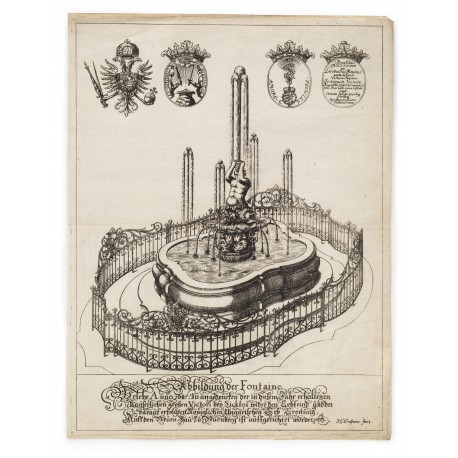 View larger
View larger
Abbildung der Fontaine Welche Anno 1687 zu angedencken der in diesem Jahr erhaltenen Kaÿserlichen großen Victorï beÿ Sicklos wider den Erbfeind und der darauf erfolgten Königlichen Ungarischen Erb Crönung, Auff den Neuen-Bau zu Nürnberg ist auffgerichtet worden J.G. Erasmus fecit
- Subjects
- Prints - Artists, German - Erasmus (Johann Georg), 1659-1710
- Sculpture - Artists, German - Bromig (Johann Leonhard), 1670-1740
- Authors/Creators
- Erasmus, Johann Georg, 1659-1710
- Artists/Illustrators
- Bromig, Johann Leonhard, 1670-1740
- Erasmus, Johann Georg, 1659-1710
- Other names
- Leopold I, Holy Roman Emperor, 1640-1705
Erasmus, Johann Georg
Nuremberg 1659 – 1710 Nuremberg
Abbildung der Fontaine Welche Anno 1687 zu angedencken der in diesem Jahr erhaltenen Kaÿserlichen großen Victorï beÿ Sicklos wider den Erbfeind und der darauf erfolgten Königlichen Ungarischen Erb Crönung, Auff den Neuen-Bau zu Nürnberg ist auffgerichtet worden J.G. Erasmus fecit.
Nuremberg, [unknown publisher], 1687
engraving (410 × 312 mm platemark, 422 × 317 mm sheet), a view of the fountain, with armorial insignia, two oval emblems (‘Consilio et Industria’ and ‘Amore et Timore’), and an oval plaque lettered: Anno Salutis mdclxxxvii quo Leopoldus Magnus parta de Turcis Victoria Maxima Josephum Filium Regem Hungariae coronari f. Hic Fons Caeto omine exsilire caepit Curante Senatu populq. Noriberg. Qui Aquam hauris Fontem Corona; in a panel below the text: Abbildung der Fontaine… (transcribed above).
provenance Zisska & Kistner, Auktion 23/i, 26 April 1994, lot 424
Slight discolouration of the margins, one short tear, otherwise a well-preserved impression.
In a museum mount.
(reduced from 410 × 312 mm platemark)
This print depicts the massive sandstone Triton fountain installed in the Neuen Bau in Nuremberg (now Maximiliansplatz), in 1689, to commemorate the Emperor Leopold i’s victories during Spring-Summer 1687 in the campaign against the Turks, and the coronation on 9 December 1687, of his son, Joseph (1678–1711), as King of Hungary. Incorporated in the ornamental ironwork railing enclosing the fountain are imperial insignia and emblems, and a tablet memorialising these events (reproduced as details across the top of the print). It is a valuable document, as the railing has since been lost and successive restorations have greatly altered the appearance of the fountain.1
The sculptor, generally identified as Johann Leonhard Bromig (1670–1740),2 took as his model Bernini’s fountain in the Piazza Barberini in Rome (1642–1643), mediated through an unidentified source. It is Bromig’s first known project and also the earliest print of Johann Georg Erasmus, the son of the designer and cabinet-maker Georg Caspar Erasmus, who became a prolific draughtsman and architect in Nuremberg.3
These impressions are known to the writer
● Berlin, Staatliche Museen zu Berlin – Preußischer Kulturbesitz, Kunstbibliothek, OS 3606 (image)4 ● Budapest, National Széchényi Library, Sándor Apponyi collection, M. 553 (record) ● Nuremberg, Stadtbibliothek5 ● Strasbourg, Bibliothèque nationale et universitaire, C.VII.108 (record)
references Christian Gottlieb Müller, Verzeichniss vom Nürnbergischen topographisch-historischen Kupferstichen und Holzschnitten (Nuremberg 1791–1801), p.159 no. 8; F.W.H. Hollstein, German etchings, engravings & woodcuts 1400–1700, viii (Amsterdam 1968), p.25
1. Georg Dehio, Handbuch der Deutschen Kunstdenkmäler. Bayern, I: Franken (Munich & Berlin 1999), p.794.
2. An alternative attribution to Johann Jacob Sommer (1645–1715), of Künzelsau, Baden-Württemberg, is proposed by Erich Mulzer, ‘Der Tritonbrunnen auf dem Maxplatz – ein Stück unbekanntes Nürnberg?’ in Nürnberger Altstadtberichte 19 (1994), pp.27–62; cf. Mulzer’s entries ‘Bromig, Schreiner-, Holzschnitzer- und Bildhauerfamilie’ and ‘Tritonbrunnen’ in Stadtlexikon Nürnberg, edited by Michael Diefenbacher and Rudolf Endres (Nuremberg 2000).
3. Christoph Gottlieb von Murr, Beschreibung der vornehmsten Merkwürdigkeiten in des H.R. Reichs freyen stadt Nürnberg und auf der Hohen Schule zu Altdorf (Nuremberg 1778), p.380, credits J.G. Erasmus for the drawing only, stating ‘Glotsch scul. Ein Bogen in Folio. Die Platte ist im Archiv’. Christian Ludwig Glotsch (d. 1719) is known for engraving other drawings by J.G. Erasmus, whose principal publication is a work on the Orders of columns, issued at Nuremberg, by David Funck and Christian Sigmund Froberger, about 1685; see British Architectural Library, Early printed books 1478–1840 (Munich 2003), no. 3844.
4. Katalog der Ornamentstichsammlung der Kunstbibliothek Berlin (Berlin 1939), no. 3606. Deutsche Digitale Bibliothek (image).
5. Katalog der historischen Ausstellung der Stadt Nürnberg auf der Jubiläums-Landes-Ausstellung (Nuremberg 1906), no. 776; Dictionary of Art, 10, p.445.





